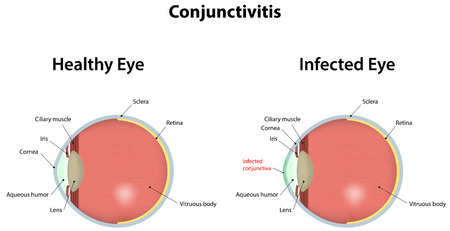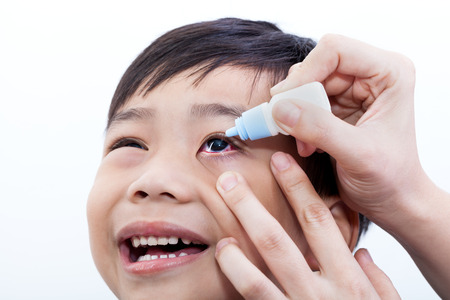Conjunctivitis is the inflammation of the conjunctiva that is the thin transparent lining over the white portion of the eye and the inner part of eyelids. It is also commonly called as pink eye because the affected eye looks reddish pink in color. It is associated with burning, itchiness and discomfort in the eye. The discharge from the eye also tends to increase because of which the eyelids get stuck to one another in the morning. Conjunctivitis can affect one or both the eyes. It is mostly acute in nature but if untreated can become chronic pink eye.

Causes of Conjunctivitis
There are a number of different causes of conjunctivitis which are as follows:
- Bacterial: The commonest organisms causing bacterial conjunctivitis are Streptococcus, Staphylococcus, Hemophilus and less commonly Clamydia Trachomatis. The bacterial conjunctivitis symptoms are redness and swelling of the eye with a typical yellowish green sticky mucopurulent discharge . It begins in one eye but since the discharge is contagious it spreads to the other eye very fast. There is a gritty and irritating feeling in the eye and also some amount of photophobia.
- Viral: Viral conjunctivitis causes are most often associated with upper respiratory tract infections like common cold. The symptoms are watering and itching in the eyes with scanty discharge. It is associated with a pinkinsh discoloration of the eye and associated iritis.
- Allergic: Allergic conjunctivitis pink eye is the inflammation of the conjunctiva due to an allergic reaction. It is associated with redness of the conjunctiva with profuse lacrymation and rhinitis. The symptoms are part of the allergic response due to the effect of release of histamine on the mast cells. The histamine causes dilatation of blood vessels, irritation of the nerve ends and secretion of tears.
- Chemical: Entry of any acidic or alkaline substance into the eye can give rise to conjunctivitis. Strong chemicals can lead to necrosis of the conjunctiva.
Other causes of conjunctivitis are those associated with reactive arthritis and the presence of gene HLA-B27.
Symptoms of Conjunctivitis
- Redness in the white portion of the eye is one of the first signs of conjunctivitis.
- Increased lacrymation (tears)
- Thick, yellow discharge from the eyes
- Sticking of the eyelids in the morning.
- Itching and burning in the eyes
- Blurring of the vision
- Photophobia-increased sensitivity to light.
Diagnosis of Conjunctivitis
The diagnosis is mainly done on the basis of symptoms and clinical examination. In some cases a swab test or a conjunctival patch may be need investigation in a laboratory.

Treatment of Conjunctivitis
The conjunctive eye treatment usually depends on the causative factor. If the conjunctivitis is bacterial in origin, or related to STDs then the treatment is mainly antibiotic eye drops which are the best prescription drops for pink eye, ointments or pills. The eye drops are medicated and they need to be instilled into both the eyes 3-4 times a day as per the dosage. Oral antibiotics are not usually needed for conjunctivitis, but if there is an associated disease then they might be given.
Viral conjunctivitis is mostly associated with a cold or rhinitis and it clears up on its own within seven days. But viral conjunctivitis is highly contagious and spreads very fast. So you need to take care by washing the hands frequently, using a separate napkin to clean the eye and washing it separately. Also if you are using contact lenses when you got the infection, you should throw away those lenses and get a new pair. Do not use make up when you have conjunctivitis.
Allergic conjunctivitis treatment is very easy. The problem tends to resolve once the irritant is taken care of. In contact lenses conjunctivitis, the lenses are the cause of the irritation of the conjunctiva, and removing the lenses can cure the inflammation.
If the conjunctivitis is caused by any foreign body or smoke, then the best solution is to irrigate the eye and to wash it with lots of cold water. Once the irritant is out, gradually the redness will go away and the eye will get back to normal.
There are popular eye drops available by the name of artificial tears. They help to clear out the irritants in the eye and also take care of the dryness of the conjunctiva.
Prevention of Conjunctivitis
- Do not touch or rub the affected eye
- Wash your hands very nicely so that the infection does not spread to the other eye or to other members of the family.
- Wash the napkins and pillow covers separately in hot water so as to disinfect them.
- Do not use eye make up
- Avoid using contact lenses. Never share your lenses with anyone.
- Do not use the eye drops used in the infected eye for the normal eye.

